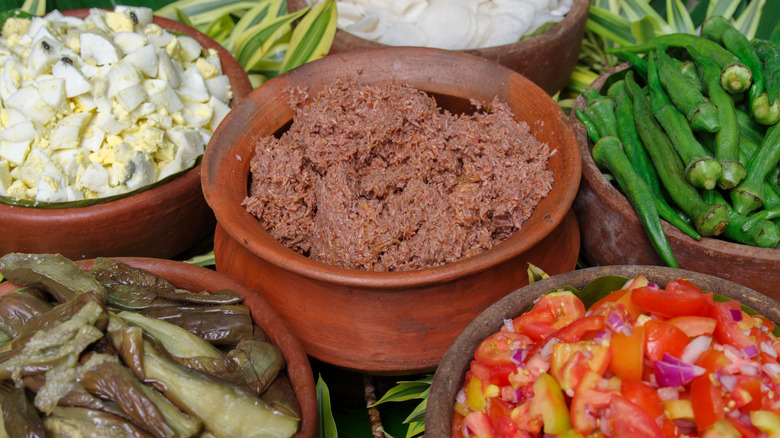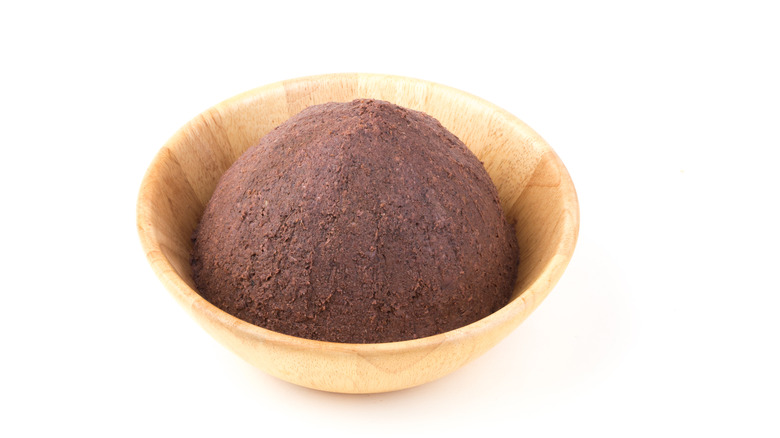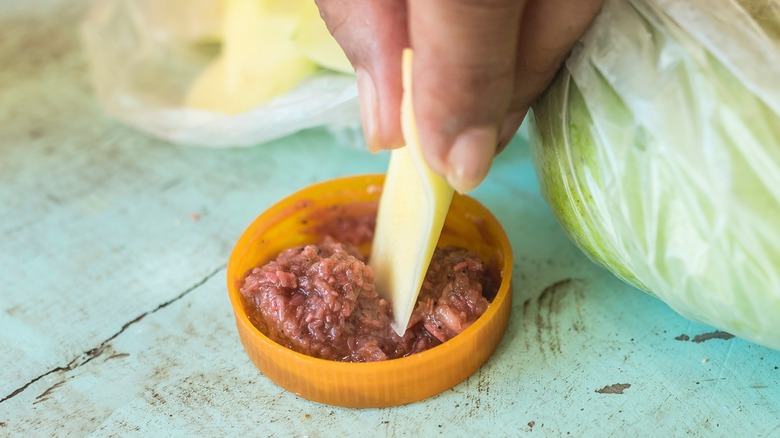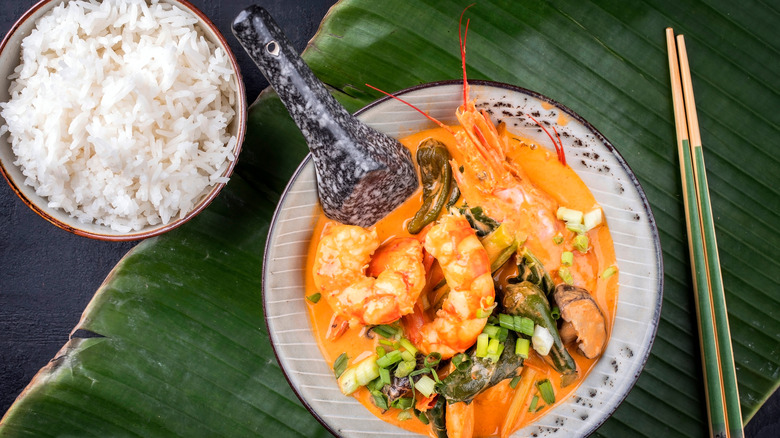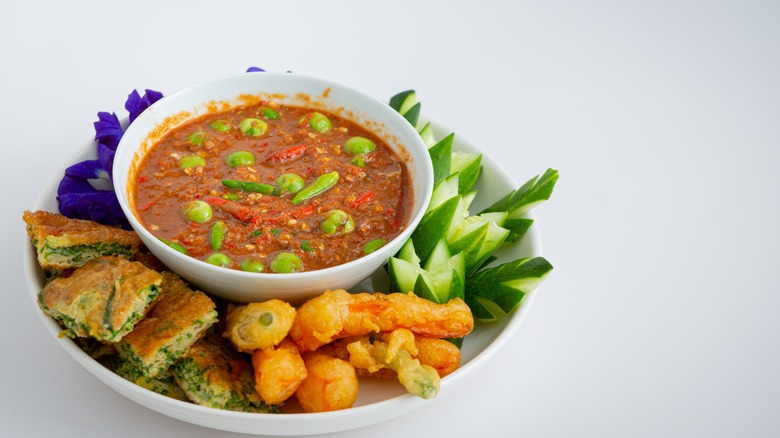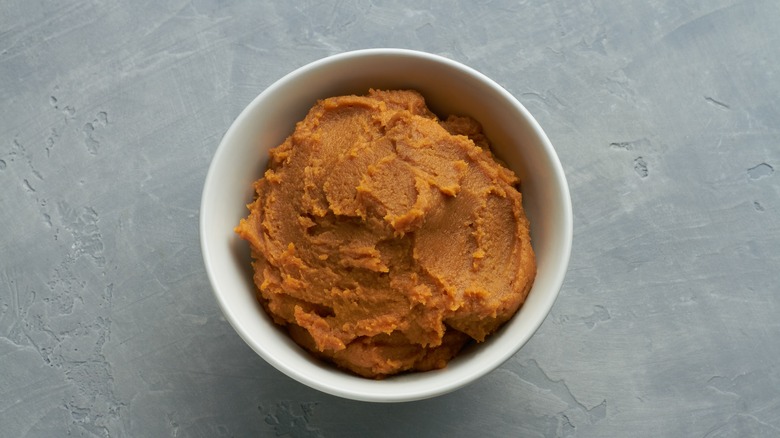Amplify Your Savory Dishes With Shrimp Paste
According to The Spruce Eats, shrimp paste could have been used in Southern Thailand as far back as the eighth century. Records of Indonesia's version of shrimp paste, known as terasi, date back to the 1400s and to the island of Java (via Systematic Reviews in Pharmacy). Its use was documented by a kingdom that existed hundreds of years before the modern-day Indonesia came to be.
And while its origin story might vary depending on whom you ask, one thing is certain: Shrimp paste is a condiment that many food cultures from Southern China to parts of Australia can't do without (as per Eater). Shrimp paste is known as bagoong alamang in the Philippines, belacan in Malaysia, kapi in Thailand, and terasi in Indonsia.
In the same way that miso brings a new flavor dimension to Japanese and South Korean cooking, shrimp paste provides the elusive pop of umami you might recognize in popular dishes from fried rice and fried noodles to curries and sambal found across Southeast Asia (as per Bon Appétit). Shrimp paste is not only used as an ingredient, it is also widely consumed as a side dish or a condiment to provide an umami and salty addition to whatever dish it happens to be served with.
How shrimp paste is made
Shrimp paste is a versatile ingredient. Its flavor profile and appearance change from country to country. Regions like Malaysia and Indonesia, which are hotter and more humid, make their shrimp paste in blocks, while in countries located further north of the equator, like Thailand and the Philippines, shrimp paste is true to its name and has a more liquid consistency (as per Eater).
In Thailand, shrimp paste or kapi is made by mixing shrimp or krill with salt and then drying that in the sun. The shrimp mix is then turned into a paste and fermented for between seven to ten days at room temperature and stored for about six months until it has developed its distinctive flavor (via Systematic Reviews in Pharmacy).
Shrimp paste, known as bagoong alamang, undergoes a similar process in the Philippines, where small shrimp or krill is cleaned in brine, salted, and then left to ferment in clay jars for up to three months (as per Kawaling Pinoy).
Food technology professor Reggie Surya tells Eater that in Indonesia, the shrimp is first boiled, then drained and salted for about two days before it is further ground down, shaped into a block, and then sun-dried. According to Surya, the paste is done when it can retain the shape of a block without crumbling. The block is further fermented for up to three months to impart additional flavor.
What does shrimp paste taste like?
To the uninitiated, shrimp paste may be a bit hard to take because its smells and flavors are both funky and intense, in a way that only shrimp that has spent time fermenting in a vat with brine or salt for an extended period of time can be.
But fortune favors the bold, and if you can get past its pungent aroma, shrimp paste delivers a bold and memorable taste sensation that is both briny and flavorsome. In the Philippines, shrimp paste can be served alongside fluffy white rice or pieces of cut fruit (as per Tatler Asia).
In other parts of Southeast Asia, shrimp paste is a key ingredient for fried rice or fried noodles, curry dishes, dips, marinades as well as sauces (via Bon Appétit). Shrimp paste is part of an ensemble, and a little shrimp paste goes a long way in enhancing the flavor of a dish rather than dominating it.
How do you cook with shrimp paste?
Shrimp paste is considered a culinary secret weapon, the way it is in the Philippines, where it is eaten with green mangoes, cooked into rice, or mixed into popular dishes (as per Tatler Asia). Shrimp paste or bagoong brings umami to fall-time Filipino favorites like the classic oxtail dish kare kare.
In Thailand, shrimp paste or kapi is added to curry paste regardless of color or as a pop of flavor to chili dips (as per Taste). Bon Appétit also recommends using it as part of a marinade for grilled or roast chicken. For Vietnamese cooks, shrimp paste or mam tom goes well with stir-fried vegetables, like the green and leafy water spinach (as per Los Angeles Times).
But because shrimp paste works so well with other ingredients, Taste says cooks shouldn't be afraid to use it to break rules and use it in a way that challenges ethnic culinary boundaries. Shrimp paste works in Western soups and sauces, and it's a toothsome alternative to anchovy in a caesar salad dressing. If you've never cooked with shrimp paste before and want to give it a go, the trick is to start off with a small amount of between a quarter to half a teaspoon and then add as needed.
Where can you buy shrimp paste?
While shrimp paste may have been considered an ethnic delicacy in the past, it is far less so today, and the condiment can now be found in the Asian food section in larger groceries chains (as per The Spruce Eats). Shrimp paste can also be found online via Amazon, where different popular brands from Thailand, Vietnam, and the Philippines are available for purchase. Some of these shrimp brands include the likes of Barrio Fiesta, Lee Kum Kee, and Kamayan, among others.
But when buying shrimp paste online, you'll need to make sure that what you're getting is fermented shrimp paste and not the fresh, smashed, and seasoned shrimp or prawn mixed with egg and cornstarch (as per Yan Kitchen). This type of shrimp paste is not just a condiment and is used as one of the raw ingredients that is cooked up in a Singapore steamboat or Chinese hotpot.
Shrimp paste's nutritional profile
Because shrimp paste is made in different ways, there are differences in the ingredient's nutritional profile. For instance, a study on Indonesian fish paste reported in Systemic Reviews in Pharmacy points out that the levels of glutamic acid, which gives the ingredient its umami quality, are higher in fish paste from Brunei as compared to Indonesia's terasi or Thailand's kapi. According to Metabolites, aside from glutamic acid, shrimp paste contains amino acids, proteins, unsaturated fatty acids, as well as aspartic acid, and antioxidants.
But as Recipal points out, while shrimp paste can also contain 273 milligrams of cholesterol, 1990 milligrams of calcium, and 21.6 milligrams of iron, it's also very high in sodium. The type of shrimp paste reported by the site had 2000 milligrams of sodium, making this ingredient a far from ideal condiment for those who suffer from hypertension. Some shrimp paste manufacturers have sought to fix this by shortening the fermentation time so that they end up with a product that has less salt and is more nutritious.
Substitutes for shrimp paste
No matter how popular shrimp paste is among its fans, it cannot be consumed by everyone: Some people do not enjoy the taste, while others have shellfish allergies or dietary restrictions. If you want to give shrimp paste a hard pass, Singapore Malaysian Recipes suggests substituting the half a teaspoon of shrimp paste with a tablespoon of fish sauce or two teaspoons of dried shrimp.
Other alternatives to shrimp paste include anchovy, which Tastylicious has the same kind of punch as Malaysian shrimp paste or belacan. The site recommends the anchovy is made into a paste before it is used as a substitute for shrimp paste.
If you're looking for vegan alternatives to shrimp paste, Tastylicious recommends miso, which can bring a similar umami quality to your recipe: Just remember to use dark miso instead of light. Singapore Malaysian Recipes also recommends using a few sliced shiitake mushrooms as a substitute for half a teaspoon of shrimp paste to add umami to vegetarian or vegan cooking.
